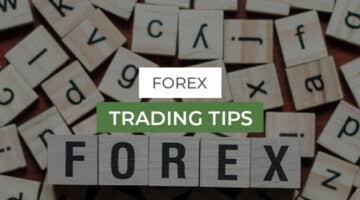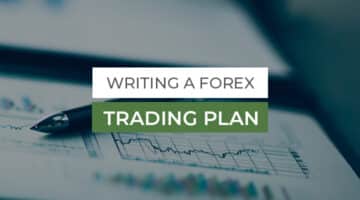What is the Moving Average Forex Indicator on MT4?

In this article
By using a few moving averages (MAs) or associated indicators, a forex trader can create an easy trading strategy to take advantage of potential trading opportunities. Trend indicators, as well as support and resistance levels, can be identified with MAs.
Moving averages (MAs) include simple moving averages (SMA), which measure prices over a given number of periods, and exponential moving averages (EMA), which emphasise recent prices. Forex trading strategies are built upon both of these pillars.
What can we learn from the simple moving average?
SMA indicators enable traders to look beyond short-term price fluctuations, enabling them to identify underlying trends of the market more clearly.
The SMA indicator can be seen smoothing out market movement in the GBPUSD chart shown above. A trader may thus be able to see a better picture of the overall market trend by analysing price and volume.
Using the SMA indicator, we can trade in a couple of ways:
- As long as the price crosses above or below the simple moving average, it can be used to initiate a buy or sell operation.
- The price must remain above or below the moving average to confirm an uptrend or a downtrend.

Moving Average Technical Indicators for Trading
Moving averages serve what purpose?
It’s essential not to misinterpret moving averages as tools that can predict future price movements in any degree of resolution since they’re lagging indicators.
The price action has already changed by moving average transitions from one slope to another. This is due to the moving average’s lagging nature.
Suppose you’re waiting for a moving average crossover to confirm an entry signal. In that case, you’ll probably have already missed it if you’re also using support and resistance strategies (or in combination with them). However, the moving average(s) may change if it returns to the level.
When confirming a trend or visualising its magnitude, moving averages are useful! A trading system must have a role, but only auxiliary.
They are sometimes used as resistance and support levels by traders. Others use crossovers between the different moving averages to confirm trend shifts and entry points.
Like all indicators, various tools and ways of assessing a trade should work together to increase the likelihood of a successful outcome.
Trending markets are the best place to use moving averages. Traders will look for the slope and rate of change of the moving average and its direction. Consequently, trends and momentum shifts in the market can often be detected more easily from moving averages than from price candlesticks alone.
Advantages and disadvantages of simple moving average
Advantages
- Even first-time traders find it easy to use because it is one of the market’s least complex forex trading tools.
- It is not susceptible to fluctuations like other trading tools. For example, a trading tool is not affected by changes in currency prices.
- Technical analysis is a reliable method for analysing market resistance and support levels.
- This is a great place for beginners to start trading forex
- Short-term noise on trading charts can be removed with this tool
Disadvantages
- In this approach, price movements in the past are more important than recent price changes.
- The same emphasis is given to every price.
- Short-term and intraday traders cannot use this as a trading tool
Things to avoid when using moving averages
Trading strategies should be based on the following rules to overcome the cons of moving averages:
- As the market approaches the moving average more often, the resistance and support levels weaken
- Large support and resistance areas are provided by moving averages that include many candlesticks (i.e., slow-moving averages).
- A moving average may offer stronger support or resistance on longer timeframes (such as on monthly or weekly charts)
SMA (simple moving average): how do you calculate it?
A simple moving average (SMA) can be calculated in various ways in the world of technical forex trading. No matter which moving average one chooses, simple moving averages require two key inputs: length and source.
SMAs are measured by their length or their “period.” The input is determined largely by the trading strategy employed and is usually measured in ticks, minutes, days, or years.
Simple moving averages also have a feature known as “source data,” specific information from previous prices.
It can be a periodic high, low, open, close, or midpoint. The trading strategy itself determines which data sources are valid, even though many traders look at the periodic close as the most important component of price action.
To demonstrate the SMA calculation, let us first gather a security’s closing prices over a period or number of trading sessions.
In our hypothetical scenario, trader A is trying to apply a 20-day SMA to EUR/USD price action during an active month on the forex market. We will rewrite the equation as follows:
Pn = Price at period n
N = Total number of periods
SMA = (P1 + P2 + … + Pn) / N
20-Day SMA = (P1 + P2 + … +P20) / 20
To calculate the EUR/USD simple moving average for the past 20 days, add up all the closing prices for that currency pair over that period, and divide by 20.
Alternatively, to compute the 200-day simple moving average of the same currency pair, you would need to take the closing values over the last 200 days and divide that sum by 200. The SMA provides a trader with an indication of which direction price action moves concerning the broader forex market.

Calculating Moving Average Technical Indicator
EMA (exponential moving average): How is it calculated?
The exponential moving average (EMA) is more complicated to calculate than the simple moving average (SMA). It gives more weight to more recent price movements to reduce the impact of lag. Forex traders should first select a period, such as ten days, and then calculate the moving average for that period.
The investor should then decide on a multiplier to emphasise recent data points. Depending on the length of the exponential moving average, the size of the multiplier will differ.
The following formula can be used to calculate the multiplier:
Multiplier = (2/ (number of time periods) + 1)
For a 10-day EMA: (2/ (10 + 1)) = 0.1818 or 18.18%
For a 20-day EMA: (2/ (20 + 1)) = 0.0952 or 9.52%
Once the multiplier has been determined, the EMA can be determined by utilising the following equation:
Multiplier x (closing price – EMA (previous day)) + EMA (last day)
Exponential moving averages involve more advanced maths. However, most moving average calculations are automated in the modern software platform, which is good for active forex traders.
To use the moving average, the user selects an SMA or EMA, defines the inputs, and applies the moving average to the price action. You can easily study market behaviour or determine support and resistance levels using this indicator.
Choosing the right moving average period
The length of moving averages employed by forex traders may differ depending on their preferences.
A long-term investor, for instance, might consider how a financial instrument performs over 200 trading days. This will provide insight into the instrument’s performance over the long term.
Individuals who focus on short-term trading might instead focus on how a currency pair has performed during a 20-day moving average window, which will give them an idea of how it has done in this comparatively short period.
Choosing the right data set is crucial regardless of the moving average used. It is ultimately the trader’s responsibility to select an appropriate periodicity. Following are some examples of how SMAs and EMAs can be applied to strategies:
- Intraday traders usually prefer eMAs due to their compressed time frames. Intraday traders should measure periods in ticks, minutes, or hours. The best charts with 1, 5, 30, and 60-minute durations.
- True day traders
- apply moving averages to 30-minute, 60-minute, and 240-minute charts. In this discipline, SMAs and EMAs are both employed.
- Investments are made based on days, weeks, months, and years. Simple moving averages are a good indicator to use with an extended horizon.
As periodicities become longer, it is crucial to understand that EMA and SMA values will diverge. Therefore, the type and moving average used in these indicators must complement the trading strategy.

Multi-moving Average Period in Trading
Steps to follow to trade forex using the MA indicator
1. Go to the trading platform after creating an account or logging in
CFDs allow you to trade forex with us. Open a live account through our online form – no funds need to be added until you want to make a trade.
2. Choose the currency pair you want to trade.
More than 80 global currency pairs are available for trading on our platform, including the world’s most traded market, forex. Several forex pairs range from major ones like EUR/USD to minor ones like HUF/EUR. Analyse the currencies in-depth, both fundamentally and technically, and make sure you understand how the currencies move concerning each other.
3. In the deal ticket, select ‘buy’ or ‘sell.’
The next step is to decide whether to ‘buy’ or ‘sell’ once you have an account (or use a demo account).
If the base currency is forecast to rise in value against the quoted currency, you would go long or ‘buy’ the pair. Conversely, you expect the base currency to fall in value against the quote to go short or click’ sell’ in the deal ticket.
4. Decide on your position size and manage your risk.
Choosing your deal size is the next step after you click ‘buy’ or ‘sell.’ You will select the number of contracts you want.
In addition, forex transactions are standardised as lots, which are batches of currency used for forex trades. Standard lots are 100,000 units, whereas micro lots are 1000 units.
Then, you need to set your stop-loss and limit orders as part of your risk management strategy – especially important when trading forex because of its volatility.
5. Trades can be opened and monitored.
The final step is to click on ‘Place Deal’ in the deal ticket to open your position once you’ve set stops and limits to manage your risk.
The ‘open positions’ section of the dealing platform allows you to monitor your trade after you’ve opened it. In addition, price alerts can be set to receive email, SMS, or push notifications when a specified level is reached.
If you are satisfied with your trade’s profit or loss and wish to close it, click the ‘close’ button when it is opened in the ‘positions’ tab of the platform. You can also close your position by reversing the trade. To sell, select ‘sell,’ and to buy, select ‘buy.’
Related questions: FAQs
1. What is the best moving average indicator?
Stock traders consider the 200-day moving average to be particularly important. Stock prices are generally considered to be in a bullish trend if the 50-day moving average is above the 200-day moving average.
2. Moving averages are good indicators.
A moving average, also known as an MA, smooths out price trends by filtering short-term fluctuations from random data. Trading signals are generated by asset prices crossing over their moving averages.
3. SMA or EMA: which is better?
With EMAs, recent data is more important than older data, which makes the results from EMAs timelier, explaining why EMAs are preferred to SMAs in many trades.
4. What is the best moving average for a 5-minute chart?
You should only use the 10 or 20 MA for quick trades that last less than an hour and use the timeframe 1 hour to confirm the trend on a higher timeframe.
5. What is the formula for calculating the 200-day moving average?
Divide by 200 the sum of the closing prices for each of the last 200 days to calculate the 200-day moving average. The 200-day moving average is calculated daily. A continuous line can be seen on the charts when all the data points are connected for each day.
Bottom line
As we have explained in this article, there are many ways to calculate a simple moving average. Using simple moving averages smooths price fluctuations and can help you spot trends. You can also use SMA indicators to generate trading signals.
All trading instruments can be used with simple moving average indicators. For example, an SMA indicator for stocks will perform just as well as an SMA indicator for forex.
Using it to understand the market trend is a very versatile tool. Check out some more indicator articles on our website if you are interested in learning more about Simple Moving Averages.
Jason Morgan is an experienced forex analyst and writer with a deep understanding of the financial markets. With over 13+ years of industry experience, he has honed his skills in analyzing and forecasting currency movements, providing valuable insights to traders and investors.
Forex Content Writer | Market Analyst
Relevant Posts

JP Markets – The Rise and Fall
[top_three_brokers] JP Markets claim to be the biggest broker of South Africa. African countries have…
Read more

FP Markets Minimum Deposit
[top_three_brokers] [single_affiliate title="" id="4271" size="big"] This guide will cover the FP Markets minimum deposit and…
Read more

Forex Trading Tips
[top_three_brokers] Every person has an equal chance of making money. However, to make money today,…
Read more

How to Handle a Bear Market
[top_three_brokers] Few things are scarier to investors than the term "bear market". Bear markets are…
Read more

GlobeX360 Minimum Deposit
[top_three_brokers] [single_affiliate id="9337" size="big"] GlobeX360 provides multiple account types, and the minimum deposit depends on…
Read more
eToro vs AvaTrade
[top_three_brokers] Overview AvaTrade is an online trading platform established in 2006. On the other hand,…
Read more

GT247 Minimum Deposit
[top_three_brokers] Would you like to know about the GT247 minimum deposit?. It is not necessary…
Read more

BDSwiss Minimum Deposit
[top_three_brokers] Are you interested in finding out what BDSwiss minimum deposit is? To trade with…
Read more

GlobeX360 Bonus Promotion
[top_three_brokers] [single_affiliate id="9337" size="big"] A broker may introduce customers to their services, attract new ones,…
Read more

Writing a Forex Trading Plan
[top_three_brokers] To successfully trade in the forex market as a beginner, it is important to…
Read more

JP Markets – The Rise and Fall
[top_three_brokers] JP Markets claim to be the biggest broker of South Africa. African countries have…

FP Markets Minimum Deposit
[top_three_brokers] [single_affiliate title="" id="4271" size="big"] This guide will cover the FP Markets minimum deposit and…

Forex Trading Tips
[top_three_brokers] Every person has an equal chance of making money. However, to make money today,…

How to Handle a Bear Market
[top_three_brokers] Few things are scarier to investors than the term "bear market". Bear markets are…

GlobeX360 Minimum Deposit
[top_three_brokers] [single_affiliate id="9337" size="big"] GlobeX360 provides multiple account types, and the minimum deposit depends on…
eToro vs AvaTrade
[top_three_brokers] Overview AvaTrade is an online trading platform established in 2006. On the other hand,…

GT247 Minimum Deposit
[top_three_brokers] Would you like to know about the GT247 minimum deposit?. It is not necessary…

BDSwiss Minimum Deposit
[top_three_brokers] Are you interested in finding out what BDSwiss minimum deposit is? To trade with…

GlobeX360 Bonus Promotion
[top_three_brokers] [single_affiliate id="9337" size="big"] A broker may introduce customers to their services, attract new ones,…

Writing a Forex Trading Plan
[top_three_brokers] To successfully trade in the forex market as a beginner, it is important to…

